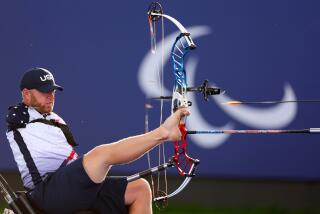THE OUTDOORS : This Sure Shot Has a Blast Triggering Improvement : Carlisle Aims to Please ‘Em
- Share via
Dan Carlisle grew up in Sheldon, Tex., a little town near Houston that he says “had one red light, and it was right before I left when we got that.”
After winning an Olympic bronze medal in trapshooting in 1984, Carlisle moved to Corona to start teaching others how to do what he does best--fire a shotgun--but Sheldon had shaped his future. It was a town in which hunting was a way of life, and a kid dreamed of owning his first gun before a bicycle.
“We could step out the back door and shoot,” Carlisle said. “I can’t remember not ever having at least a BB gun. My dad took me quail hunting when I was about 10. First I didn’t get to carry a gun, then I got to carry a gun without any bullets. He broke me in that way, so I’d be safe.
“I’d been bugging him about a shotgun for a couple of years. One day he said, ‘OK, if you can hit this can every time I throw it up, I’ll buy you a shotgun.’ ”
Carlisle practiced.
“One day he came home and I was waiting on him with a can. I never missed. The very next day I had my gun.”
Carlisle, who will be 33 next month, still doesn’t miss. Well, not often. He can hold the gun behind his back and hit a fast-moving clay target coming from over his head.
With a pump-action piece, he can hit a dirt clod thrown into the air, eject the shell casing into the air and blast that, too, and succeeding shells, one after another.
Don’t try that at home. Carlisle is among the best in the world at handling a shotgun. He was the top American in the Olympics this year, placing fourth in skeet, just missing a bronze, and ninth in trap.
In trapshooting, competitors fire at mechanically released clay disks, called birds or pigeons, from 5 stations, each 16 yards from the target. Skeet has 8 shooting stations 21 yards from the target but the shooter does not know where the pigeons will be released.
As part of his School of Shotgun Shooting, Carlisle is conducting a series of clinics in another kind of shooting, sporting clays, at Raahauge’s Pheasant Hunting Club in Norco. Sporting clays, featuring a variety of flights of artificial targets in natural habitat settings, is a spinoff of trap and skeet. It started in Texas and has grown rapidly in the last few years.
“It’s a lot like golf courses because every one’s different,” Carlisle said. “Whatever the terrain’s like is what the course is like. It’s not the same old trap and skeet . . . the same technical, mechanical type shooting. This takes more agility and thinking. From station to station it’s different.”
But it doesn’t pay much. Carlisle received $1,200, a shotgun and “a nice buckle” for winning the recent West Coast championship at Raahauge’s. It may grow, though, and meanwhile, Carlisle imparts his knowledge to others, for a fee.
A typical class, limited to 10, will include husbands, wives, fathers and sons, brothers and cousins. “Most of them come out to improve their hunting,” Carlisle said. “We haven’t gone into the sporting clays aspect of the sport enough to draw that crowd yet.
“But if they’re hunters, I can guarantee them at least 20% (improvement). Somebody who’s never shot, 50%.”
The real test will come in the field, with live game.
“The thing that makes it tougher then is the excitement,” Carlisle said.
On the range, alongside other shooters, there is a tendency to become competitive.
“You get guys that don’t know each other and the ridin’ gets a little too serious,” Carlisle said. “The money starts comin’ out of the pockets. You have to get in there and loosen ‘em up.”
Last Sunday’s group had two fathers with two sons each and some hunting buddies from around Southern California. Although all had been handling shotguns for a while, Carlisle started them out with basics, such as how to hold one--”Three-fingered grip on the forehand, like a golf grip; tight grip on the backhand, first joint of the finger on the trigger.”--and how to line up a target on the fly.
He distributed some 6-inch pieces of cardboard with half-inch holes in the center and instructed the class to hold them at arm’s length, both eyes open, and pick out “the fork in that big oak tree over there” through the hole in the card.
Carlisle covered one hunter’s eye, then the other, and asked when the fork disappeared. The eye that retained a view of the fork was the dominant eye--ideally, the right eye for a right-handed shooter.
“Otherwise, you must close (the dominant) eye to shoot,” Carlisle said.
Also, he added: “Shotguns are made to point, not to aim. We focus on the object we’re shooting at, not on the sights.”
Right away, several students realized they had some bad habits to break.
Moving through five shooting stands in the dense brush and forest of Raahauge’s 3,500 acres during the day, the class’s only sense of being an hour from downtown Los Angeles was the frequent small plane and helicopter traffic overhead. Carlisle constantly preached his doctrine about “tracking” a thrown target by allowing it to move past the line of the gun, then sweeping back to it from behind in its flight path and firing when the gap is closed.
Another tip: when firing toward two or more birds, shoot only for one.
“You never hit anything shooting at the flock,” Carlisle said. “Pick one out and you’ll hit him.”
As the shooters got the hang of it, the ground became littered with shell casings and shattered remnants of the 4-inch, round, orange clay disks used as targets. Carlisle, constantly reminding and encouraging as he moved from one shooter to another, got excited himself. He seemed to be willing the clay birds to break and his pupils to succeed.
“I tell ‘em if I don’t teach ‘em anything, I’ll give ‘em their money back--or they’ll be out here till way past dark,” he said, laughing.
“One time I did (have) a guy I couldn’t teach anything to. Worked with him a couple hours and he would not let me in his head. I finally said, ‘You’d better go take up golf. This game isn’t for you.’
“It’s easier for me to take a person that’s never shot before and teach him the right basics in the beginning. Every time they pick up the gun, they’ll get better. They’ll never go back (to bad habits). But trying to teach a guy that’s been shooting 20 years already, as soon as those quail get back up he has to think to do it the right away instead of just letting it happen, until that thought process is soaked in.
“I can tell you how to shoot all day long, but once you load the gun . . . A good example today: I showed one of the guys how to grip the gun--OK, no problem. Soon as he loads the gun, he’s right back to the way he was, finger off the trigger, (yelling,) ‘Pull! Pull!’ ”
Later, it became clear that the skill came more naturally to some than to others. Bruce Shirley of Walnut was there with his father Tom and brother Lynn--all good shots--but at one point Carlisle singled out Bruce.
“See how aggressive he is with it?” Carlisle said. “That’s how I want everybody to shoot.”
Carlisle said he doesn’t hunt as often as he’d like to, but shooting at flying clay targets is second nature.
“My dad would throw clay targets in the back yard. I worked at this little turkey-shoot club on Sundays. I’d make 10 bucks and would spend 8 of it on trap at the end of the day. My dad would buy my shells. That’s how I learned to shoot trap.”
Now, he thinks sporting clays is more fun. He won the West Coast title with a score of 174 out of 200, which would be terrible in trap or skeet shooting but beat runner-up Walt Tabor of Torrance by 18 points.
“There’s more room for error in sporting clays,” Carlisle said. “In trap, you have to break the 199, 200 straight to win, where in skeet you have to break 400 straight.
“In sporting clays, there’s more thinking--when to bring the gun up, when to make the shot. You might watch the bird for 4 or 5 seconds before you’re ready to shoot. It’s the only game in shooting you can miss the first 10 out and still win the tournament.”
Under international rules in the Olympics, one doesn’t have nearly that latitude.
“I went out there the last day a bronze medalist and came back fourth,” Carlisle said. “The guy that won the bronze (Jorge Guardiola of Spain), we tied but they had a tiebreaker (round). He beat me on the last 25. The shooters, we don’t think that’s fair. We figure a score’s a score. They changed the rules to try to get the media more involved.”
The pressure can be intense. In ‘76, Carlisle failed to make the U.S. Olympic team.
“I’d won ‘most every shoot that year, but going to the national championships--the big choke. It happens. In skeet I had some gun problems. In trap, I just went out there too nervous.”
This year, the shooting was dominated by Eastern Bloc sharpshooters, who won 10 of the 13 gold medals in men’s and women’s competition. In shotguns, Dimitri Monakov of the Soviet Union won trap and Axel Wegner of East Germany won skeet.
“The Communists have taken over,” Carlisle said, smiling. “Most of their shooters are policemen or military. The government subsidizes ‘em. (A number of U.S. Olympians have also been members of the U.S. Army Marksmanship Unit at Ft. Benning, Ga.). But I’ve seen Russians come and go--world champions--and they’re younger than I am, and if they screw up, you never see ‘em again. Next year you’ll see a new one, and the guy shoots like a house afire.”
For all Carlisle knows, an Olympic medalist could come from one of his classes. Sunday, as the chill and the mosquitoes settled in at sunset, the class was polled on what it had learned.
Tom Shirley: “Concentration (and) to point that lead hand with the bird.”
Dave Finch of Walnut: “Not using the sights and using a fluid motion.”
Bruce Shirley: “Shooting with one eye closed.”
Art Midgley of Baldy Mesa: “How to follow the bird.”
George Inman Jr. of Azusa, attending with his father and brother Bill, was sold on Carlisle’s methods.
“Anybody who can stand behind you and tell you what you’re doing wrong and you immediately improve, he must know what he’s doing,” Inman said.
Wayne Chmelsky of Canoga Park said: “Banging three doubles in a row really made the day for me. Before, I’d have to bang off 10 boxes of shells to get my limit of doves. I wouldn’t have to do that now.”
It was almost dark, but all the ammo and clay targets weren’t used up. Carlisle, unable to resist the chance to show off a little, ordered his trappers to throw out three at once. He broke them all.
“Just wanted to see if I could still do it,” he said.
More to Read
Go beyond the scoreboard
Get the latest on L.A.'s teams in the daily Sports Report newsletter.
You may occasionally receive promotional content from the Los Angeles Times.






